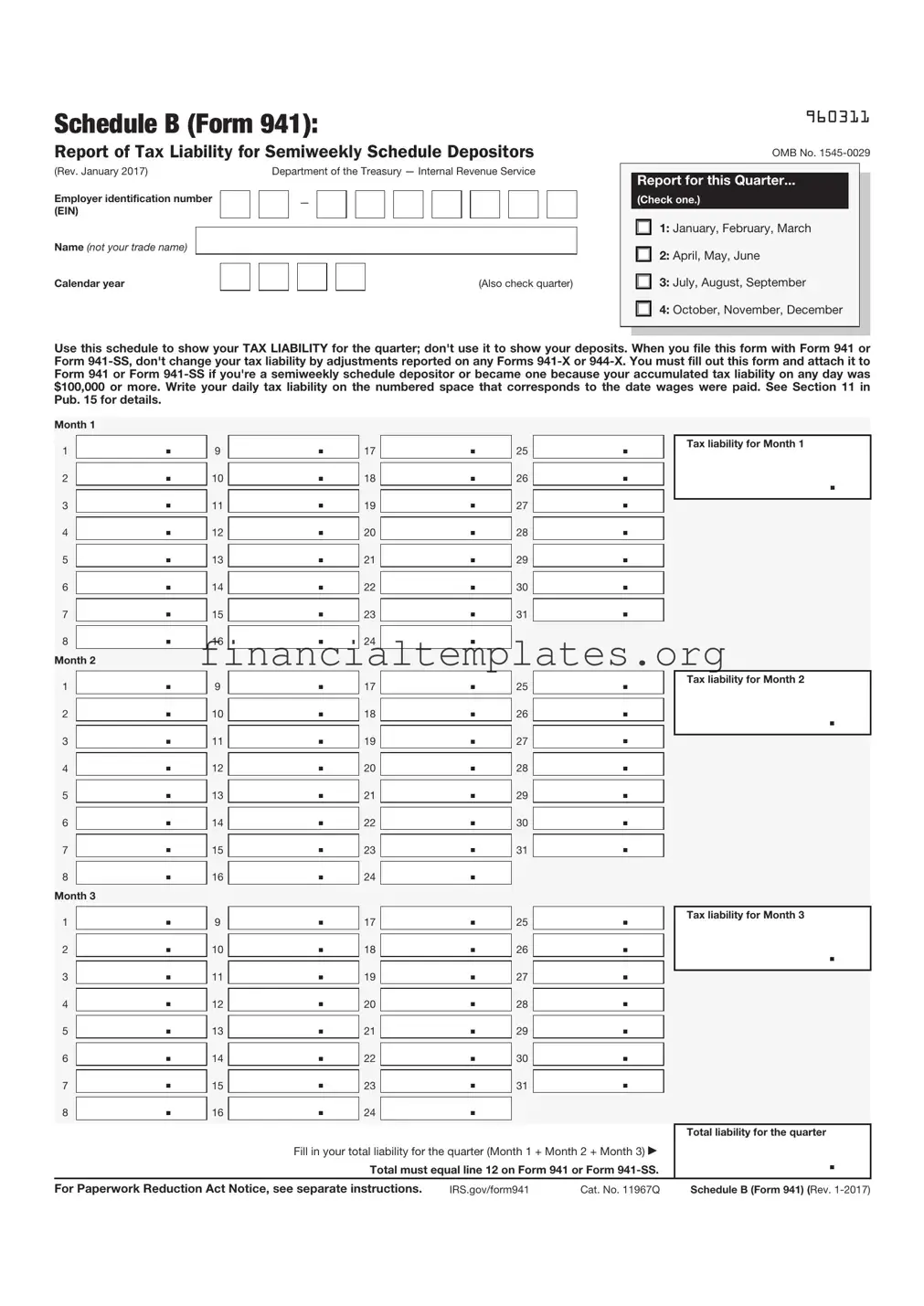The IRS Schedule B (Form 941), a companion to the Employer's Quarterly Federal Tax Return, closely aligns with Form 940, the Employer's Annual Federal Unemployment (FUTA) Tax Return. Both forms are integral components of federal tax reporting for employers, detailing tax liabilities owed to the federal government. However, while Schedule B breaks down a taxpayer's liability on a semi-weekly or monthly basis for each quarter, Form 940 captures an annual overview of unemployment taxes due. This key difference in the frequency of reporting does not diminish their similarity in purpose — to ensure employers report and pay taxes appropriately to support federal programs.
Similarly, Form 944, the Employer’s Annual Federal Tax Return, bears resemblance to Schedule B of Form 941 in its intention to streamline tax reporting and payment for small employers. The primary difference lies in the reporting period; as suggested by the title, Form 944 is utilized on an annual basis, aimed at businesses with a smaller tax liability. This offers a simpler alternative for smaller enterprises, reducing the need for frequent filings while maintaining the essential function of reporting employment taxes to the IRS. Both forms are designed with the employer's responsibility in mind — ensuring timely and accurate tax payments.
The IRS Schedule B is also akin to Form W-2, the Wage and Tax Statement. Though Schedule B and Form W-2 serve distinctly different functions — one being for the employer's quarterly tax liability and the other for reporting annual wages and taxes withheld from employees — they share a fundamental similarity. Both forms are critical for the IRS's collection and reconciliation of taxes, ensuring that employers are withholding and remitting the correct amount of taxes on behalf of their employees. Thus, despite their differences in scope and purpose, both documents are pivotal to the IRS's operations.
The Form W-3, Transmittal of Wage and Tax Statements, complements the functionality of IRS Schedule B by summarizing the total earnings, social security wages, Medicare wages, and withholding for all employees for the year. While Schedule B is used alongside Form 941 to report employment tax liabilities quarterly, Form W-3, in conjunction with Form W-2, provides an annual summary directly to the Social Security Administration. This form ensures that the data from individual W-2s are accurately totaled and reported, facilitating the cross-verification of reported tax liabilities and withheld taxes, an essential process paralleled in the intent behind Schedule B.
Lastly, the relationship between Schedule B (Form 941) and Form 1040, the U.S. Individual Income Tax Return, highlights the comprehensive ecosystem of tax reporting and collection. Although Form 1040 pertains to individual taxpayers and Schedule B to employers, both serve as critical links in the IRS's chain of tax collection and compliance. Schedule B details the employer's tax liabilities on a more granular, periodic basis, whereas Form 1040 summarizes an individual's annual income and taxes due. This contrast underscores the broader tax landscape's interconnected nature, where varied forms ensure thorough and equitable tax collection from all fronts.


 .
. .
. .
. .
. .
. .
. .
. .
. .
. .
. .
. .
. .
. .
. .
. .
. .
. .
. .
. .
. .
. .
. .
. .
. .
. .
. .
. .
. .
. .
. .
. .
. .
. .
. .
. .
. .
. .
. .
. .
. .
. .
. .
. .
. .
. .
. .
. .
. .
. .
. .
. .
. .
. .
. .
. .
. .
. .
. .
. .
. .
. .
.